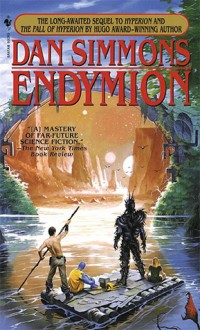
The Hyperion universe is as creative as they come; imaginatively futuristic and fantastic with historic contextualization, deterministic and fatalistic, but ultimately about choices, sprawling, massive and intimate - it fits into a category of its own.
Endymion continues that tradition in all of its wonder and indulgent fun. I'm kind of glad I waited a while from the finish of [b:The Fall of Hyperion|77565|The Fall of Hyperion (Hyperion Cantos, #2)|Dan Simmons|http://d.gr-assets.com/books/1329610795s/77565.jpg|1882596] before picking up this continuation. Sure, I forgot a lot of the complicated details that wrapped up the first part of the tale, but Simmons reacquaints you with them directly.
Endymion picks up nearly three hundred years after the events of
Fall of Hyperion and is partly narrated by the book's namesake, Raul Endymion, whose fate is entwined with a prophet set to change the universe: the young Aenea who is the child of Brawne Lamia and the Keats cybrid sent forward in time through the time tombs to her waiting destiny.
Endymion reads kind of like a post-apocalyptic travelogue of the old web worlds. It's an interesting feeling and an interesting twist to a genre that's currently so much en vogue. Instead of the dystopic semi-futuristic civilization among the ruins of the familiar contemporary Earth setting we tour the technologically regressed remains of an impossibly high tech civilization that spanned stars. Travel has become "primitive" (the farcasters and fatline are gone) and pocket communities within reasonable relativistic time-debt distance of each other have sprouted up with limited economies and an almost phobic rejection of all things resembling artificial intelligence. In the place of the once powerful and sprawling Hegemony is the Pax a militant and politically resurgent Catholic Church asserting dominion over the former Web and converting people by the billions and establishing a theocratic reactionary empire. Their sales pitch: well, they're not the Ousters and they can finally legitimately deliver on the one promise the Church had offered with complete ambiguity in the past: resurrection and life eternal. Somehow, the Church has mastered the use of the cruciforms from the original Hyperion tales preventing the dumbing and de-individualizing effects of cruciform resurrection that plagued the primitive Bikura people from the anthropologically oriented Priest's Tale in book one. The promise of eternal life has interesting consequences and Simmons deals with it in wonderfully imaginative sciencey ways that are surprising and yet maniacally practical in building his post-Hegemony universe. (One of the ways he gets around time-debt from relativistic travel (the only means he has left to get his characters around) is the creation of the Archangel class ships of the Pax that accelerate so quickly that they smoosh the passengers to a micrometer thin coating of jelly within creches inside the ship, which is not a major obstacle to travel if you can resurrect yourself from death once you get where you're going. Genius and macabre at the same time. My only technical problem is that if the acceleration does that to the human body at 200 g's then the glass bulbs of the coffee machines on the ship that miraculously and automatically brew you a divine cup of joe upon coming back to life wouldn't stand a chance.)
Endymion is narrated by Raul from a distant point in the future in which he's imprisoned. He recounts his early adventures with the child prophet - her appearance and rescue and their multi-world pilgrimage through the ruins of the Hegemony - while alternating chapters tell the tale of Father Captain de Soya - a militaristic priest in the employ the Church who are hunting the child to silence her and prevent her from fulfilling her destiny. Much of the appeal of the book is the revisitation of the key planets in the old Hyperion tale to see how they've changed and how the universe is evolving after the fall. As such, if you're fresh off [b:The Fall of Hyperion|77565|The Fall of Hyperion (Hyperion Cantos, #2)|Dan Simmons|http://d.gr-assets.com/books/1329610795s/77565.jpg|1882596], you may find the travel notes and familiar settings redundant, but again, having taken a six month break in-between books 2 and 3, I found the reacquainting process enjoyable.
Endymion has just enough grounding in the familiar and well-loved characters and locales of Hyperion to feel like you're returning to an old friend and enough drama, great characterization and action to help you feel like you're starting on a brand new adventure without having the burden of being hung-up on the differences between said old friend and this new tale. There's a continuous narrative thread from the Hyperion series, but its not restricting and
Endymion is very much its own story. I'm afraid some of the burning questions (especially regarding the fate of Rachel and Sol don't get resolved and may never get resolved), but the Shrike does make an appearance and we do learn at least a little bit more about our creepy metallic friend by the end of this story.
A worthy continuation of probably one of the most ambitious, eloquent and complicated science fiction stories out there. Best resumed after a hiatus, in my opinion.



 Log in with Facebook
Log in with Facebook 








